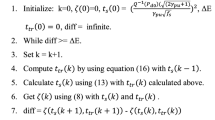Abstract
We propose capacity optimization through sensing threshold adaptation for sensing-based cognitive radio networks. The objective function of the proposed optimization is the maximization of the capacity at the secondary user subject to transmit power and sensing threshold constraints for protecting the primary user. After proving the concavity of capacity on sensing threshold, the problem is solved using the Lagrange duality decomposition method in conjunction with a subgradient iterative algorithm. The numerical results show that the proposed optimization can lead to significant capacity maximization for the secondary user as long as this is affordable to the primary user.
Similar content being viewed by others
References
Haykin S.: Cognitive radio: Brain-empowered wireless communications. IEEE J. Sel. Areas Commun. 23(2), 201–220 (2005)
Zhao Q., Sadler B.: A survey of dynamic spectrum access. IEEE Signal Process. Mag. 24(3), 79–89 (2007)
Kang X., Liang Y.-C., Garg H.K., Zhang L.: Sensing-based spectrum sharing in cognitive radio networks. IEEE Trans. Veh. Tech. 58(8), 4649–4654 (2009)
Musavian L., Aïssa S.: Capacity and power allocation for spectrum-sharing communications in fading channels. IEEE Trans Wirel. Commun. 8(1), 148–156 (2009)
Xin K., Liang Y.-C., Nallanathan A., Garg H.K., Zhang R.: Optimal power allocation for fading channels in cognitive radio networks: ergodic capacity and outage capacity. IEEE Trans. Wirel. Commun. 8(2), 940–950 (2009)
Oliveira, C., Pardalos, P.M.: A distributed optimization algorithm for power control in wireless ad hoc networks. In: IEEE 18th International Parallel and Distributed Processing Symposium (IPDPS’04), vol. 7, pp. 177–185. Santa Fe, New Mexico (2004)
Choi, H., Jang, K., Cheong, Y.: Adaptive sensing threshold control based on transmission power in cognitive radio systems. In: 3rd International Conference on Cognitive Radio or Wireless Networks and Communication, CrownCom (2008)
Digham F.F., Alouni M.-S., Simon M.K.: On the energy detection of unknown signals over fading channels. IEEE Trans. Commun. 55(1), 21–24 (2007)
Zhang, R.: Optimal power control over fading cognitive radio channels by exploiting primary user CSI. In: Proceedings of the IEEE Global Communication Conference (Globecom), New Orleans, USA (2008)
Chen Y., Zhao Q., Swami A.: Joint design and separation principle for opportunistic spectrum access in the presence of sensing errors. IEEE Trans. Inf. Theory 54(5), 2053–2071 (2008)
Stephen, B., Lieven, V.: Convex optimization. Cambridge University Press, London (2004). ISBN: 978-0-521-83378-3
Nedić, A.: Subgradient methods for convex minimization. Ph.D. dissertation, MIT (2002)
Andrea, G.: Wireless Communications. Campridge University Press, London (2005). ISBN: 978-0521837163
Resende, M.G.C., Pardalos, P.M.: Handbook of Optimization in Telecommunications. Springer, New York (2006). ISBN: 9780387306629 (978-0387306629)
Bertsekas, D.P.: Nonlinear programming, 2nd edn. Athena Scientific, Belmont (1995). ISBN: 1886529000 (1-886529-00-0)
Pardalos, P.M., Resende, M.G.C.: Handbook of Applied Optimization. Oxford University Press, USA (2002). ISBN: 0195125940 (978-0195125948)
Ribeiro A., Giannakis G.B.: Separation principles in wireless networking. IEEE Trans. Inf. Theory. 56(9), 4488–4505 (2010)
Palomar D.P., Chiang M.: A tutorial on decomposition methods for network utility maximization. IEEE J. Sel. Areas Commun. 24(8), 1439–1451 (2006)
Author information
Authors and Affiliations
Corresponding author
Rights and permissions
About this article
Cite this article
Foukalas, F.T., Karetsos, G.T. & Merakos, L.F. Capacity optimization through sensing threshold adaptation for cognitive radio networks. Optim Lett 6, 1499–1511 (2012). https://doi.org/10.1007/s11590-011-0345-8
Received:
Accepted:
Published:
Issue Date:
DOI: https://doi.org/10.1007/s11590-011-0345-8




